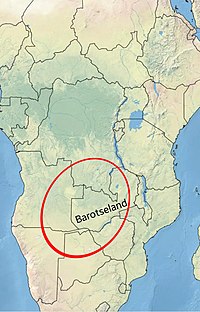
Back بروتسلاند Arabic Regne de Barotselàndia Catalan Barotseland Czech Barotseland Danish Barotseland German Barotselandia Spanish Barotseland Basque Barotsemaa Finnish Barotseland French Barotseland ID
This article has multiple issues. Please help improve it or discuss these issues on the talk page. (Learn how and when to remove these messages)
|
Kingdom of Barotseland | |
|---|---|
 Approximate location of Barotseland | |
| Capital | Mongu |
| Common languages | Lozi, English |
| Demonym(s) | Barotse, Barotselandian |
| Area | |
• Total | 252,386 km2 (97,447 sq mi) |
| Person | muLozi, Murotse |
|---|---|
| People | baLozi, Barotse |
| Language | Silozi, Rozi |
| Country | Barotseland, Bulozi |
Barotseland (Lozi: Mubuso Bulozi) is a region between Namibia, Angola, Botswana, Zimbabwe including half of north-western province, southern province, and parts of Lusaka, Central, and Copperbelt provinces of Zambia and the whole of Democratic Republic of Congo's Katanga Province. It is the homeland of the Lozi people or Barotse,[1] or Malozi, who are a unified group of over 46 individual formerly diverse tribes related through kinship, whose original branch are the Luyi (Maluyi), and also assimilated Southern Sotho tribe of South Africa known as the Makololo.[2][3]
The Barotse speak siLozi, a language most closely related to Sesotho. Barotseland covers an area of 252,386 square kilometres, but is estimated to have been twice as large at certain points in its history.[4] Once an empire, the Kingdom stretched into Namibia, Angola, Botswana, Zimbabwe including half of eastern and northern provinces of Zambia and the Democratic Republic of Congo's Katanga Province.[5]
Under the British colonial administration, Barotseland was a protectorate of the British Crown from the late 19th-century. The Litunga, the monarch of Barotseland, had negotiated agreements, first with the British South African Company (BSAC), and then with the British government that ensured the kingdom maintained much of its traditional authority under the Litunga. Barotseland was essentially a nation-state, a protectorate within the larger protectorate of Northern Rhodesia. In return for this protectorate status, the Litunga gave the BSAC mineral exploration rights in Barotseland.[6]
In 1964, Barotseland became part of Zambia when that country achieved independence. In 2012, a group of traditional Lozi leaders, calling itself the Barotseland National Council, called for independence; other tribal chieftains oppose secession, however.[7]
- ^ The prefixes "Ma-" (singular) or "Ba-" (plural) indicate "a man / the people/tribe of"; "Lozi" or "-rotse" are different interpretations/spellings of the same word. "Si-" indicates the language.
- ^ Phiri, Bizeck J. (2005). "Lozi Kingdom and the Kololo". In Shillington, Kevin (ed.). Encyclopedia of African History, Volume II, H-O. New York: Fitzroy Dearborn (Routledge). pp. 851–852. ISBN 978-1-57958-454-2.
- ^ "Barotseland". Unrepresented Nations and Peoples Organization. Archived from the original on 3 January 2014.
- ^ "Politics and Economics of Barotseland - Kuomboka Geographic". sites.google.com. Archived from the original on 17 October 2020. Retrieved 25 May 2020.
- ^ Katulwende, Malama (2005). Bitterness (An African Novel from Zambia). Mondial. ISBN 978-1-59569-031-9.
- ^ "All shook up: Zambia's president Michael Sata broke a 2011 campaign promise to restore the Barotseland kingdom's autonomy". Good Governance Africa. Archived from the original on 7 April 2014.
- ^ Cite error: The named reference
BBCseekswas invoked but never defined (see the help page).

